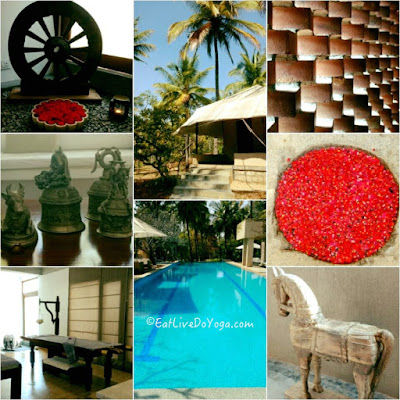 |
Open on all sides and nestled amidst gorgeous trees, this Yogashala has
a beautiful, positive vibe. |
“Hamsa Soham, Soham Ham Saha”, these simple yet extremely
powerful words mean “I Am That, That I Am”. Even if this mantra was the only
gift that I took back with me from this yoga retreat, it would make the three
days spent here on my own totally worth it. But my time at Shreyas gave me a
lot more. It simply reminded me of what yoga means to me and how good it makes me feel. Yet, this mantra
has stayed with me; and whenever I need to centre myself, at times before going
to sleep, at others before the start of a frenetic day, just repeating it
mentally on a loop has a magical effect on my being.
First Glance
When I was invited to
Shreyas, a yoga retreat on the outskirts of Bengaluru, I was, both, excited and
anxious. Excited because I am extremely passionate about yoga and when I was
told that the entire philosophy of Shreyas is centred around yoga I couldn’t
wait to experience it. Anxious because for the last few months with soaring
professional and personal demands I had not been able to make the time to get
on to my yoga mat. My joints had literally been creaking every morning when I
got out of bed and I wondered how I’d cope with the routine of the retreat. But
almost as soon as I reached Shreyas I am taken in by its relaxed, tranquil and
positive vibe. These are not just random adjectives that I have thrown
together; I mean each one of them describe the space that Shreyas is.
After a brief
introduction, I am asked to fill a detailed form to highlight the purpose of my
visit, my expectations whether spiritual, therapeutic or simply relaxing, my
current state of health, dietary preferences and so on. As I get up to check in
to my room, I am informed about the routine of the day followed with a
wonderful question: “would you like a reminder for each event?” No, I replied
as reminders, like alarms, irk me. I like to keep track of time and pace myself
to reach a class or therapy session on time.
The Surroundings
As I walk past the
inviting swimming pool, surrounded with the lush foliage that Bengaluru is
known for, I am impressed with the wonderful upkeep of the landscape. Shreyas
is not a new property, it has been around for more than fourteen years, yet
everything looks so fresh and as if it has been lovingly tended to. My garden
tented cottage has a canopied roof with a private sit-out, a spacious bedroom,
and bathroom with a private walled courtyard. Simply luxurious, I could say.
Spread across 25 acres
of coconut plantation, gardens and vegetable fields, it is surprising that
there are only 14 rooms, accommodating a maximum of 25 people at a time. I am
informed later that the staff outnumbers the guests by more than three times.
That is what enables Shreyas to excel in the subtle art of refined hospitality.
The service is very warm and attentive, and unobtrusive. To give you an
endearing example, all indoor spaces require us to leave our footwear outside
before entering, and each time when we leave the room our shoes and slippers
are turned around for us to simply step into them and walk.
A Holistic Experience
As I mentioned
earlier, the entire philosophy of Shreyas is centered around yoga. And as we
know, yoga is not limited to just asana and pranayama. It is a holistic science
of living and has an eight-limbed path
impacting our panchakoshas. With
equal importance to raising one’s energy, partaking a nutritious balanced diet,
and indulging in activities that integrate the mind, body and soul, Shreyas
truly offers a holistic retreat. The sound meditation, for instance, is a
highly energising experience with equal importance given to all steps of
meditation – pratyahara (withdrawal), dharana (focus) and dhyana (meditation). It
is normally conducted in pillared hall that is open on all sides, bringing in
the freshness of the environ, sounds of birds and insects while they go about doing
their business amidst the hum of a gentle breeze blowing through the trees,
literally getting you in tune with nature. The same hall is also used for
morning and evening asana sessions though there are a few other indoor and
outdoor spaces where hatha and ashtanga yoga classes are held.
Rejuvenation of the
mind-body-soul is hardly ever possible without the right diet. Whether your
purpose of being here is to ‘detox’ or not, you will be served delicious,
vegetarian fare. During the few days that I spent here, I had fabulous local,
north Indian, Italian and Mexican meals, all made with mostly organic produce
and healthy grains. The cooking classes, therefore, are hugely popular,
enabling guests to take back a bank of recipes and a wealth of knowledge.
 |
| Snapshots from Shreyas Yoga Retreat |
Integrative Therpaies
Yoga is known for its therapeutic benefits as well as prevention of diseases. In this sense,
it is closely linked with Ayurveda. The recent addition to Shreyas has been the
Anaha spa which offers a wonderful mix of age-old Ayurvedic as well as modern
therapies. Although it is a new construction, it is aesthetically designed to showcase
an interplay of the elements. As with most things, what lies within is most
important - in this case, a specialised team to assess your physical condition, advise
appropriate treatments and execute them skillfully.
I am advised a range
of treatments that are cleansing as well as nourishing.
-
Netra
Tarpana therapy that involves a gentle oleation of the eyes to soothe them is
particularly refreshing and a great antidote to constant visual stimulation
from brightly lit gadgets.
- Mud therapy involves the application
of processed, powdered mud onto the body for therapeutic benefits. The open air
room is ideal for this as one lies gazing at the swaying palms overhead while
waiting for the mud to dry.
- In a similar space, Athapa Snana
involves a gentle, oil massage, after which the body is wrapped in banana
leaves and left to bask in the sun, expelling toxins through sweat. Banana leaves are also known for their
healing properties, and can correct various skin problems.
- The underwater massage turns out to
be a high-tech procedure where the body is immersed in a water tub, and the
water pressure applied is controlled by multiple jet valves, enhancing blood
circulation and lymphatic drainage.
-
And
finally, a synchronized massage known as the Choorna Pinda Sweda, also known as
the Podikizhi. It is a fomentation procedure involving the use of herbal
powders and poultices after a quick oil massage. Two therapists working
simultaneously on the left and ride sides of the body has an inimitable
centering effect.
Most scrubs and concoctions are
prepared in-house in keeping with instructions from classic Ayurvedic texts. But
beyond Ayurvedic treatments, the team is equipped and trained for international
therapies as well including Swedish, Balinese and Thai.
I, of course, made the
most of my time here and also realized the importance of going on such a yoga
retreat – it gives you time to unwind and get a break from the rat race that
most of us have inadvertently become a part of; experience the importance of
taking care of one’s self; spend time with like-minded people; and, carry that
motivation back home with you: to stay consistent with yoga!
This article was first published in Hong Kong based Asana Journal, September 2017 issue.




